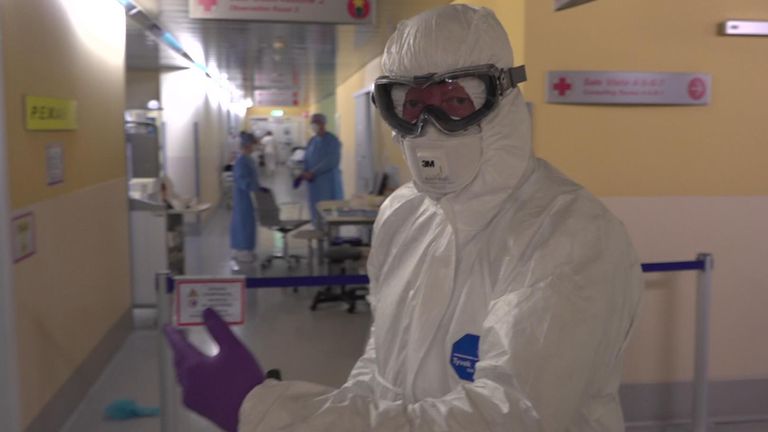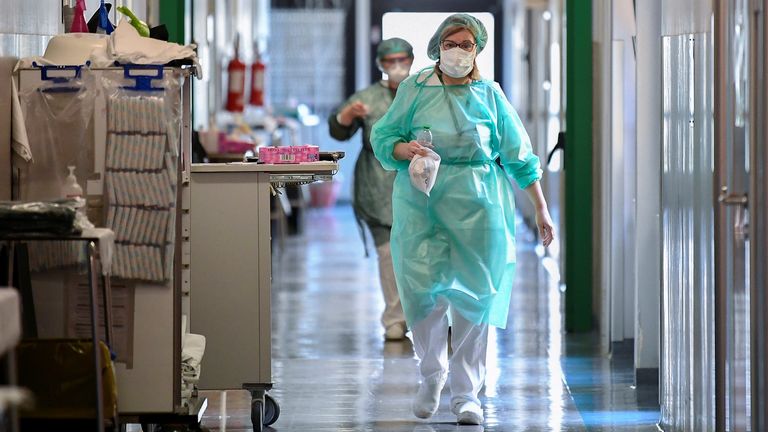‘It was carnage. I won’t forget what I saw’: Sky journalist reflects on Europe’s first COVID epicentre
A year ago, Stuart Ramsay walked into “every worst nightmare we had imagined” when he and his crew filmed in hospitals at the epicentre of the world coronavirus outbreak.
This is how he remembers that day, which contains descriptions of suffering some may find upsetting.
It was dawn on a cold March morning in Milan – 19 March to be exact.
I woke with a dull ache in my left arm; I think I had been lying awkwardly on my arm in a night of broken sleep.
I showered then met the team and we started loading our gear into our van.
Nobody said much.
We were going to Bergamo and Cremona in the northern Italian province of Lombardy.
We were going to the worst-hit hospitals in the world for COVID-19. We had no idea what to expect other than a huge day of work.
I looked at Garwen Mcluckie, my cameraman and my friend of many years, as he pushed the final piece of kit into the boot.
“So, we’re going to the worst-hit hospital, in the worst-hit town, in the worst-hit province, in the worst-hit country in the world, mate – how you feeling?”
He looked at me. He always grins. He wasn’t.
We set off not knowing what to expect.
Our date with Bergamo had been set 24 hours earlier after a series of meetings with officials that led to us being allowed to enter the hospitals at the centre of the COVID storm.
The previous day had been a non-stop act of preparation.
Apart from a handful of people, nobody knew we were in Lombardy.
The people who did know were full of reservations.
My producer, Dominique Van Heerden, had spent the day writing obligatory risk assessment forms and preparing us for the final phone call with the bosses.
There is no subterfuge in modern journalism. If you want to do a story with risk you have to explain what you are doing, what your plans are and what safety protocols are in place.
We were trained, we had the right gear, we had the permissions – and we knew this story needed to be done.
We arrived at the hospital.
The Papa Giovanni XXIII is magnificent. I said it at the time, and I say it now: it is the best hospital I have ever been inside.
The head of media met us at the back entrance for staff. She did not want us there.
We are friends now. But back then she was in shock. We didn’t understand why at the time.
Vanna Toninelli led us inside the vast modern complex. It was effectively empty. The hospital was closed to everything but COVID-19 cases.
We asked for time to prepare ourselves and put on our protective equipment.
My hands shook as I dressed.
Vanna then walked us through the hospital towards the accident and emergency section.
We entered a waiting room.
It was full of people on gurneys, people sitting on chairs, people lying on chairs, all of them struggling to breathe.
We started filming – Garwen at the first patient and nurse he saw, Dominique splitting away and filming row after row of people. We had less than an hour inside.
Vanna called me over and introduced me to Dr Roberto Cosentini, the head of emergency admissions.
He seemed almost relieved for someone other than his staff to witness what was going on.
“I need to show you things, Stuart, so you can understand,” he said to me.
“Doctor, I need my team to work through this. We’ve never seen anything like this,” I said through my unfamiliar full body protective gear.
“Ok, Stuart, take your time, I understand,” he said.
What we were seeing was every worst nightmare we had imagined. It was like a movie. And it was happening right in front of my eyes.
We weren’t in the intensive care unit, we weren’t inside the hospital, we were in the corridors that lead to the emergency wards. It was carnage.
I won’t forget what I saw.
But more, much more, I remember my first thoughts clearly: “Oh my God, we are going to get smashed in the UK. My family and everyone I know is going to get smashed. We have to tell everyone. We have to show everyone, now.”
We filmed for probably an hour or so.
Every minute remains with me as we watched people in the last throes of life and staff with a wide-eyed look of disbelief attempting to save lives and trying to control their own panic.
We left and undressed from our protective gear.
Our Italian producer Simone Baglivo, who had waited outside, asked us how it was.
None of us said much. We were still processing it – and everything was about the report we needed to file. But incredibly we had another appointment at the ICU in Cremona Hospital.
Normally I would have called it and said: we have the report, let’s pull off and file it.
But Dominique was focused and said we must do this, and we can do this and still file on time. We couldn’t let the second hospital down.
We drove for an hour and arrived at Cremona.
We dressed again and entered the ICU.
It’s not unusual to see reporting from inside hospitals treating COVID-19 patients now – but at the time none of this had been seen first-hand by anyone.
Not for a hundred years has a pandemic engulfed first world countries with such calamitous affect.
The staff inside were utterly, utterly exhausted.
The people they were trying to save were dying by the hour.
The place was a maze of patients on respirators being turned over as they struggled to keep them alive.
They didn’t really know what would or wouldn’t work. They were trying everything.
We interviewed a neurosurgeon, Dr Emanuela Catenacci, who’d been co-opted to help in ICU.
She was a brilliant interview and we finished. Then she pulled me aside.
“I want to say something more,” she whispered.
I, of course, said yes, what is it?
“You have to understand, the worst part for us, is that everyone dies alone. Do you understand?”
It hit me like a thunderbolt. Of course. Nobody can come and see their relatives.
Everyone dies alone.
Tears filled her eyes and I wanted to hug her, but I couldn’t.
We regrouped as we took off our equipment.
Nobody said much. It was a day like that.
We drove to Milan and filed our first report for the news that evening.
The message from Italy was sent.
Now much of Europe is facing another wave of the virus.
The numbers in Italy are even more worrying than they were back then.
The vaccine rollout in most of Europe is not going well.
A year on, I write this on an equally cold March morning, and I have an ache in my left arm. But it’s different now.
I slept well last night. My ache is my vaccine shot.
Source: Read Full Article







